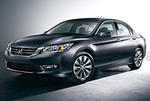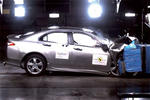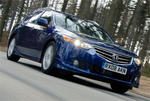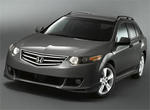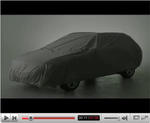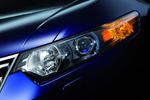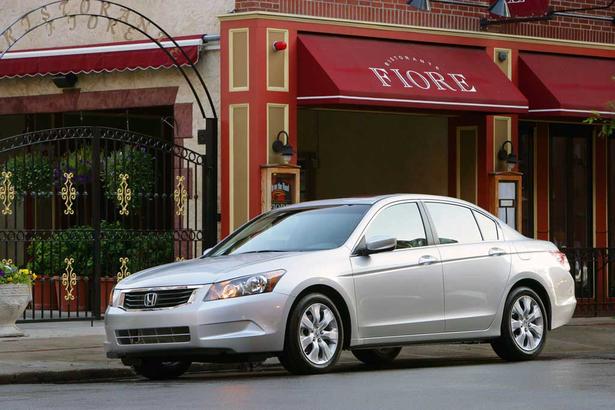
The 2008 Honda Accord safety features include: 4-wheel disc Anti-lock Brake System (ABS), Electronic Brake Distribution (EBD) and brake assist, Standard Vehicle Stability Assist(VSA) with traction control (Electronic Stability Control), Standard Tire Pressure Monitoring System (TPMS).
Honda Press Release:
2008 Honda Accord – Safety
Overview
Honda seeks to provide a high level of occupant and pedestrian protection in all of its cars and trucks through a comprehensive approach to vehicle safety. This process, which honors the
company's Safety for Everyone initiative introduced in 2003, benefits all new Honda vehicles - regardless of size or price - while also increasing compatibility with other types of vehicles in a collision.
Consistent with the Safety for Everyone initiative, every 2008 Accord integrates sophisticated safety technology that includes the Advanced Compatibility Engineering™ (ACE™) body structure and dual-stage, dual-threshold driver's and front passenger's airbags (SRS); driver's and front
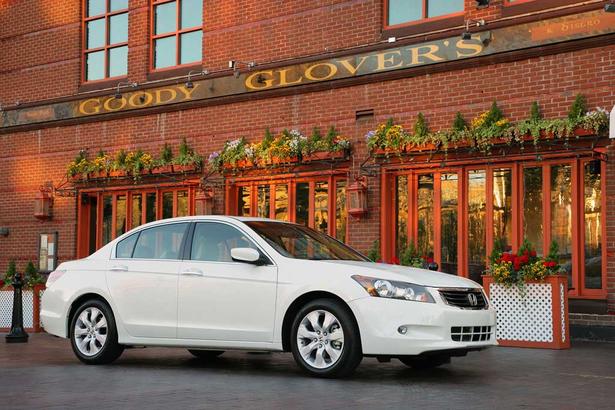
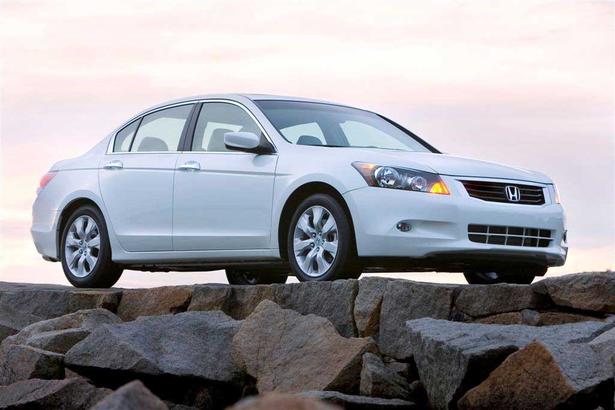
passenger's dual-chamber side airbags; and side curtain airbags. The ACE body structure enhances frontal collision energy management through a network of load-bearing front frame structures designed to improve the likelihood for two vehicles to connect during a frontal collision in such a way as to absorb more crash energy compared to a conventional design.
Advanced Safety Technology
Inside, every Accord incorporates newly-designed side-curtain airbags and dual-chamber front- side airbags with a passenger-side Occupant Position Detection System (OPDS), along with active front
head restraints that are designed to help reduce the severity of neck injury in the event of a rear collision. Additional standard safety features include dual-stage, dual-threshold front airbags with a passenger-side Occupant Position Detection System (OPDS), an Anti-lock Brake System (ABS) with brake assist, front seatbelts with pre-tensioners and load limiters, and pedestrian safety design in the front of the vehicle. Driver and front passenger seatbelt reminders and daytime running lights are also standard equipment.
The 2008 Accord safety features include:
Standard active safety systems
- 4-wheel disc Anti-lock Brake System (ABS), Electronic Brake Distribution (EBD) and brake assist
- Standard Vehicle Stability Assist™ (VSA ®) with traction control (Electronic Stability Control)
- Standard Tire Pressure Monitoring System (TPMS)
Standard passive safety systems
- ACE body structure
- 3-point seatbelts at all positions
- Front seatbelt load limiters and pre-tensioners
- Dual-stage, dual-threshold front airbags
- Advanced dual-chamber front-seat side airbags
- All-row side curtain airbags for outboard occupant positions
- Active front head restraints
- Rear head restraints for all seating positions
- Lower Anchors and Tethers for CHildren (LATCH) system in the rear seat
- Front and rear 5-mph bumpers
Advanced Compatibility Engineering™ (ACE™) Body Structure
At the heart of every new Accord is an exceptionally strong foundation based on the latest version of Honda's Advanced Compatibility Engineering (ACE™) body structure technology. The revolutionary ACE system makes the new Accord highly effective at absorbing the energy of a frontal crash and helps minimize the potential for under-ride or over-ride situations that can happen during head-on or offset frontal impacts with a significantly larger or smaller vehicle. Using a sophisticated computer-assisted design process, the ACE system creates a network of fully integrated load-bearing elements that help attenuate peak impact forces by more evenly distributing them across a relatively large area in the front of the vehicle.
Unlike most conventional designs that direct frontal crash energy only to the lower load-bearing structures in the front end, the ACE system actively channels frontal crash energy to both upper and lower structural elements, including the floor frame rails, side sills and A-pillars. By creating specifically engineered "pathways" that help distribute these frontal impact forces through a greater percentage of the vehicle's total structure, the ACE system can more effectively route them around and away from the passenger compartment to help limit cabin deformation and further improve occupant protection. Integral to the ACE concept is its unique front polygonal main design structure.
Structural Enhancements
Comprehensive structural enhancements can be found throughout the new Accord unit body, which now contains 48% high-strength steel. The main longitudinal frame rails have been redesigned and repositioned above the floor panel rather than below to further improve the car's ability to withstand severe side-impacts, while new and more robust rear structural elements add rigidity and help the Accord meet the stringent new FMVSS 301 regulations.
Pedestrian Safety Design
Structures in the front of the Accord are designed to help absorb energy in the event of a collision with a pedestrian. Research by Honda shows that the following features can dramatically improve a pedestrian's chance of survival if struck by a moving vehicle.
Key pedestrian safety features:
- Hood is designed to deform if contact is made with either an adult or a child pedestrian
- Sufficient clearance exists between the hood and hard engine parts
- Windshield base has a boxed frame structure for efficient impact energy absorption
- Energy-absorbing fender mounts and supports
- Deformable windshield wiper pivots
- Deformable hood hinge
Offset Rear Collision
The new FMVSS 301 regulation is more severe than the previous standard. This regulation began its phase-in during September 2006 and must be applied to all production vehicles after September 1, 2008. In the new requirements for the FMVSS 301 standard, a 1,360 kg (2,992 lbs.) deformable barrier strikes 70% of the vehicle's width at 50 mph. In contrast, the previous FMVSS 301 used a 1,814 kg (3,991 lbs.) flat rigid barrier that struck the full width of the vehicle at 30 mph. The new standard requires more body energy absorption than before. It is Honda's strategy to offer this high level of rear impact protection on the Accord before it is mandated by the NHTSA.
Standard Vehicle Stability Assist™ (VSA ®) with Traction Control and Brake Assist
Vehicle Stability Assist (VSA) is an Electronic Stability Control system that works in conjunction with the Accord's drive-by-wire throttle and its 4-channel ABS systems to enhance controllability while the vehicle is accelerating, braking, cornering or when the driver makes a sudden maneuver. VSA functions by applying brake force to one or more wheels independently while also managing the throttle, ignition and fuel systems to help the vehicle maintain the driver's intended path of travel.
The VSA system constantly analyzes data from seven sensors that monitor wheel and vehicle speed, steering input, lateral G forces and yaw rate. It compares the driver's control inputs with the vehicle's actual response. Whenever the actual response falls outside of a predetermined acceptable range, VSA intervenes with a corrective action.
For instance, if VSA detects an oversteer condition, the system may apply braking force to the outside front and rear wheels to counteract the unintended yawing effect. In the event of understeer, VSA may apply braking to the inside rear wheel while reducing engine power to help return the car to its intended course. VSA also provides a limited-slip differential effect for the front wheels by applying braking force to a slipping wheel, thereby redirecting driving force to the wheel with more traction.
Emergency Braking
Another key VSA function is recognizing emergency braking situations and almost instantly applying added braking force. This brake assist feature is controlled by a special logic in the system that determines when the pedal stroke and speed exceed a typical range - as they would in a panic stop.
At that point, the VSA modulator pump increases braking pressure while the pedal is still being pressed to ensure maximum stopping force, an action that helps shorten braking distance as much as possible.
VSA is calibrated to function in a near-transparent manner, and in many cases a driver will not even be aware of its operation. However, anytime the system is enhancing vehicle stability, an indicator light flashes in the instrument cluster. While the driver can deactivate the VSA stability enhancement and traction-control functions via a switch on the instrument panel, ABS remains fully operational at all times.
Advanced 4-Channel ABS with Electronic Brake Distribution
A new and enhanced anti-lock braking system has been developed for the 2008 Accord. This sophisticated 4-channel/4-sensor anti-lock package replaces the system found on the 7th generation Accord.
All 2008 Accord models, regardless of engine or trim level, are fitted with 4-wheel disc brakes that have vented front rotors and solid rear rotors. (Please see Chassis tab for more information.) Thanks to a more rigidly mounted master cylinder, the 2008 Accord's brake pedal has a firmer feel and a shorter activation stroke. The new ABS system also incorporates Electronic Brake Distribution (EBD) circuitry that automatically proportions force based on the vehicle's weight distribution.
Dual-Stage, Dual-Threshold Front Airbags
Both the driver and front passenger are protected by advanced front airbags that incorporate dual-stage and dual-threshold activation technology. These two features work together in the event of a deployment while helping minimize injuries that can sometimes be caused by the airbags themselves. Honda's sophisticated dual-stage, dual-threshold system is designed to optimize the deployment rate to match both the speed and severity of a crash event. The control logic also takes several other factors into consideration, including the relative seat position of the driver and the weight of the front seat passenger, as well as whether the seat belts are in use at the time.
During a lower-speed collision, or if the seat is too close to the steering wheel, the inflators in the driver's frontal airbag will activate sequentially to help mitigate the initial force. In a high-speed collision, or if the seat is positioned farther back, both igniters are triggered simultaneously for full and rapid inflation. The passenger-side frontal airbag is designed to operate in a similar manner, however a sensor under the passenger seat calculates whether the weight on the lower cushion meets a NHTSA-specified minimum value. If it doesn't, the airbag is deactivated, as indicated by a light on the instrument panel.
Like other Honda vehicles, the driver's front airbag is located in the steering wheel while the passenger airbag is located on the top of the dash. When deployed, the passenger airbag inflates upward and then rearward to maximize its protective potential while reducing the likelihood of injuries being caused by the activation process itself.
Side-Curtain Airbags
Standard side-curtain airbags provide enhanced head protection for outboard occupants of the front and rear seats in all 2008 Accord models. A new design for Honda, the Accord side-curtain airbag design first inflates a main chamber, then a connected sub chamber. This design allows the main chamber to remain inflated for a slightly longer time following a crash. Inputs from side impact sensors and a central sensor are used to determine when to deploy the side curtain airbags.
Advanced Dual-Chamber Front-Seat Side Airbags
All 2008 Accord models are fitted with front-seat side airbags featuring a new dual-chamber design that offers enhanced protection for the torso and pelvis in case of a severe side impact. Replacing the previous single-chamber airbags, these new dual-chamber units are comprised of a larger upper chamber that provides improved protection for the chest area as well as a smaller lower chamber that focuses coverage on the lower-back/hip area. A single inflator unit fills both chambers. These new dual-chamber airbags are significantly more effective in helping minimize the potential for injuries being caused by impacts from larger vehicles, such as a side impact involving a truck or SUV.
Front Seatbelts with Pretensioners and Load Limiters
The front seatbelts in all 2008 Accord models are equipped with pretensioners and load limiters to help minimize injury potential in a frontal collision. When an impact occurs, the pretensioner tightens the seatbelt (shoulder and lap) to help hold the seat occupant firmly in position. Each front seatbelt retractor incorporates a load limiter that works in conjunction with the pretensioner. In response to the occupant's input, the load limiter functions by permitting a small amount of controlled seatbelt slack shortly after the pretensioner is activated to limit the peak restraining forces, reducing the potential of serious injury. The front seatbelts in all Accords also feature adjustable shoulder anchors. Three-point seatbelts are standard in all three rear seating positions.
Active Front Head Restraints
Each of the Accord's front seats are fitted with an innovative active head restraint designed to help reduce the severity of neck injuries in the event of a rear impact. The head restraint is mechanically connected to a lumbar plate located inside of the seatback via special links. If a rear impact takes place, the passenger's body is pushed against the seatback. That action causes the head restraint to move forward in a carefully prescribed arc. The effect of this motion helps equalize the impact forces being transmitted to the head, neck and spine throughout the collision as the occupant's head moves backward. Effectively managing and evenly disbursing these energy spikes is a critical factor in helping minimize the potential for injuries.
Adjustable Rear Head Restraints for All Seating Positions
The rear seats in both the Accord Sedan and Coupe feature individually adjustable head restraints for all three passenger positions.
Lower Anchors and Tethers for CHildren (LATCH)
The outboard rear seating positions in all 2008 Accord models are fitted with Lower Anchors and Tethers for CHildren (LATCH) that provide a simple and secure method of installing up to two compatible child safety seats. Alternately, the center position incorporates an upper tether that makes it possible to fit a single child safety seat in either the Sedan or Coupe. When a child seat is in the center position, additional child seats may not be used in the outboard positions.
Tire Pressure Monitoring System (TPMS)
All Accord models are fitted with a new direct Tire Pressure Monitoring System (TPMS) that alerts a driver whenever the air pressure in one or more of the vehicle's tires decreases significantly below the recommended level. Using four sensors (one in each tire) TPMS monitors and transmits information on tire air pressure to the Accord's ECU. When the pressure in one or more tires drops to a potentially critical level, it causes a low tire pressure indicator (located in the instrument cluster) to illuminate.





